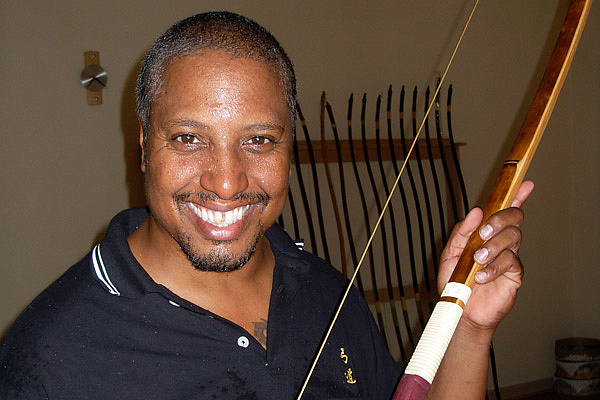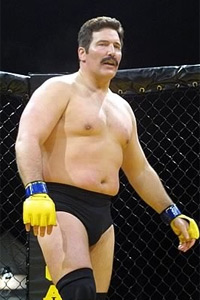Marcus Bossett: Where is He Now?
Budo
Jason Probst Nov 3, 2010

Budo is as budo does, and for Marcus Bossett, the pursuit and application of the Japanese concept was integral to whatever he did.
Advertisement
Held on Dec. 16 in Tulsa, Okla., UFC 4 was a typically chaotic affair, featuring a cross section of ne’er-do-wells, harvested from the spectrum of fighting disciplines. Winning a reserve match by knocking out Eldo Dias Xavier, Bossett sat cage-side scouting the competition as the night progressed. He saw a lot more than the fans, both in person and on pay-per-view, could have imagined.
There was Kevin Rosier,
who had gone 1-1 in the first UFC a year previous, back for another
go in the one-night tournament format, down to eight men from its
original 16-man format. Rosier, in the early stage of a
professional boxing career that would leave him as a 7-17 trial
horse, was not exactly pulling the typical prefight ritual.
“When you saw Rosier walk to the ring [to warm up], he’s got a head full of hair. But when he goes into ring to fight, he cut it all off, using tape scissors in the locker room,” Bossett says. “He tried to shave his head at first but couldn’t. So he took those scissors instead. He didn’t want anyone to pull his head.”
In addition to the hair modification -- a stylistic tip of the hat to the Gracie-Kimo battle at UFC 3, where Royce’s timely hair pull stopped Kimo’s menacing assault -- Rosier was also getting decidedly loose as his fight with Joe “Ghetto Man” Charles approached.
“Rosier was downstairs, drinking vodka and eating candy bars. That’s why Joe Charles whipped his ass in like 13 seconds,” Bossett says. “His metabolism was probably all over the place.”
Later, Bossett encountered fellow UFC 4 neophyte Melton Bowen, a professional boxer whose claim to fame was once staggering contender and title challenger Carl “The Truth” Williams in a rollicking match in which Bowen was eventually stopped. Bowen was a fairly good heavyweight, a fringe contender on his better days, and clad in strange gear nobody had yet seen -- the early version of what are MMA gloves. Why the new gear?
“I told Bowen, man, have you seen this s--t? He said no, man, I’m a hardcore boxer. I’m gonna hit somebody with my s--t. I’m gonna kill him,” Bossett says. “But [Bowen, facing Steven Jennum) couldn’t grab anything. And that’s the reason I got in.”
After Jennum’s rousing brawl with the tough Bowen, capped off by a nice armbar from mount after Bowen absorbed a series of solid punches from his back, Jennum had injured his hand, ironically enough, on the boxer who was worried about killing people with his own.

File Photo
“That’s the reason I got to fight [Dan] Severn,” Bossett says. “Jennum jacked his hand up. I’d sat there ringside and saw Severn suplex [Anthony Macias] four times in a row. I’m thinking, ‘He’s going to break his neck.’ I’m evaluating everybody. From my years of fighting, I can look at someone and evaluate what they do and determine how to get in on them. I looked at Severn, and if you let him get a hand on you, you’re done. I absolutely, positively did that until I did my signature move -- the spinning back kick. In tournaments, Professional Karate League, my spinning back kick was my signature move. I’ve taken people’s heads off with it.”
It was also an exceptionally daring gambit at the time, when the sport’s striking largely consisted of sloppy stand-up and primitive brawls. Bossett brought a tight, concise and wicked back kick that night at Severn, something which, if it had connected, could have opened the pathway to untold riches and opportunities.
Instead, his go-to move merely opened up the door to Severn’s world, as the world-class wrestler did something new and readily effective. He went “wrassler,” a tactic that would be used by Mark Coleman, Matt Hughes, Tito Ortiz, Randy Couture and every other cauliflower-eared guy who had spent a lifetime on a mat knowing exactly how to plant people there.
“Dan did something no one had ever done. He ducked down low and tackled me. Once he got on me, I couldn’t get him off,” Bossett says. “I had my finger four inches down his throat. He was just squeezing. I said, ‘You know what? It ain’t worth being in a wheelchair. He’s one corn-fed white boy.’”
Bossett submitted to an arm-triangle choke -- a submission well-known by wrestlers competing in MMA at the time and one Coleman would use to defeat Severn at UFC 12 three years later.
Calm after the Storm
At Ultimate Ultimate 1996, Bossett made his second appearance, this after losing via submission in the United Full Contact Federation a few months earlier to Carl Franks. He was still eager to learn the ground game but had trouble finding people with which to train. Bossett drew Steve Nelmark, who eschewed the stand-up battle Bossett wanted for a ground-style snoozer.
“It was a whole bunch of nothing going on. He never could pin me down; it was just back and forth,” he says. “I never got any stand-up time. I was getting tired. I never got to stand up.”
Bossett lost via choke. That was the end of his career, at least where mainstream events were concerned. Bossett later trained with noted grappling savant Gokor Chivichyan, adding to his ground game the skills he knows he could have used in those early UFC bouts, where grappling was more an esoteric concept than something competitors could implement in the heat of battle.
To this day, it still bothers him that the ground skills he finally learned were never really there when he had his most significant fights.
“I did UFC 4, then a year later, there’s UFC 5, and everybody is recognizing me in the airport. With Ultimate Ultimate, all of a sudden everybody’s blowing up with this thing,” Bossett says. “I never felt like I had the shot I wanted. I had a bad EKG going into Ultimate Ultimate, and they made me sign a different waiver so I couldn’t sue. I was willing to die on the line for it.”
Today, Bossett is happily married and has a 1-year-old daughter, Miwa. He’s far more stable than he was during some admittedly dark periods in his life, one of which included a cross-country driving spree after a tumultuous marriage to his first wife.
“To be quite honest, I lost my mind. I literally drove around the country for 11 months. I’d see a karate school, go inside and say, ‘I’m Marcus. I did an Ultimate Fight. How would you like to do a seminar?’ We’d split the door, and I’m gone. And I’d teach a couple nights at their dojo … nine months I did that,” Bossett says. “I went from here to Homestead, Fla., California, Texas, Atlanta, [Washington] D.C., Tennessee and Homestead, Fla., where you can look out at night and see the lights of Cuba. I realized I was chasing some s--t I was never gonna catch. So I called my wife. She said, ‘Well, I dunno if I want you back.’ I thought she was fooling around. She was in Playboy 1995.
“So I decided I’d drive back,” he adds. “If she was in my house, I would kill anything else that moved. Or I’m gonna leave her alone and never see her again. Drove from Florida, like a crazy person. Nothing was outta place. That’s another reason why I fell off the map. I said, ‘OK, everything’s in place. I’m leaving.’ She was everything to me. I gave her up.”
Related Articles







